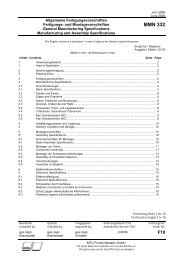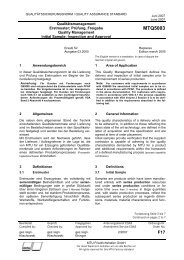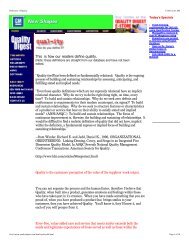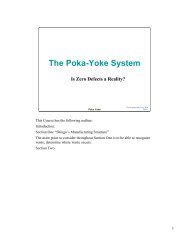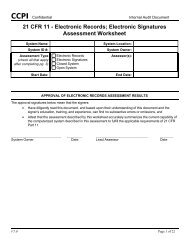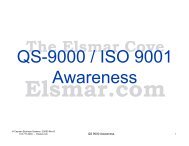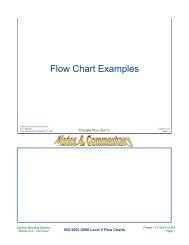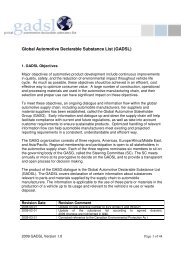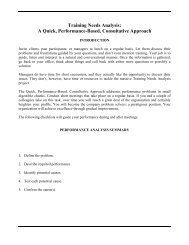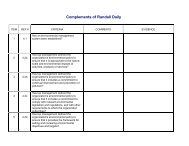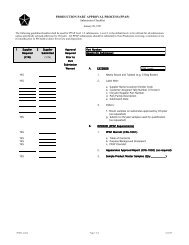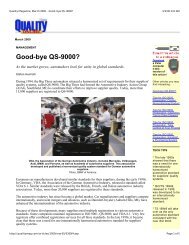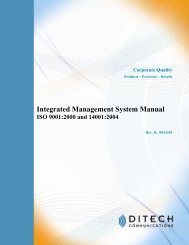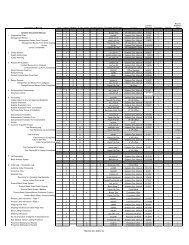ISO 9001:2000 Checklist
ISO 9001:2000 Checklist
ISO 9001:2000 Checklist
Create successful ePaper yourself
Turn your PDF publications into a flip-book with our unique Google optimized e-Paper software.
<strong>ISO</strong> <strong>9001</strong>:<strong>2000</strong> <strong>Checklist</strong><br />
<strong>ISO</strong><br />
Clause<br />
Question Answer Notes:<br />
4.1 General Requirements<br />
A quality management system has been<br />
established, documented, implemented,<br />
maintained, and continually improved?<br />
Does the quality management system include:<br />
a. identification of the processes needed for the<br />
quality management system?<br />
b. determination of the sequence and interaction<br />
of these processes?<br />
c. determined criteria and methods required<br />
ensuring the effective operation and control of<br />
these processes?<br />
d. the availability of information necessary to<br />
support the operation and monitoring of these<br />
processes?<br />
e. methods to measure monitor and analyze<br />
these processes?<br />
f. implemented action necessary to achieve<br />
planned results and continual improvement?<br />
Are processes that are outsourced that may affect<br />
product or service conformity identified and<br />
documented?<br />
4.2.1 General Documentation Requirements<br />
Does the quality management system<br />
documentation include documented procedures<br />
and records required ensuring effective operation<br />
and control of its processes?<br />
Is the extent of the quality management system<br />
documentation appropriate to:<br />
a. Size and type of the organization?<br />
b. Complexity and interaction of the processes?<br />
c. Competence of personnel?<br />
Does the quality system documentation include:<br />
a. a documented quality policy and quality<br />
objectives?<br />
Yes No<br />
Yes No<br />
Yes No<br />
Yes No<br />
Yes No<br />
Yes No<br />
Yes No<br />
Yes No<br />
Yes No<br />
Yes No<br />
Yes No<br />
Yes No<br />
Yes No<br />
QF 4.1-9 01/31/02 Page 1 of 18
<strong>ISO</strong><br />
Clause<br />
b. a quality manual?<br />
<strong>ISO</strong> <strong>9001</strong>:<strong>2000</strong> <strong>Checklist</strong><br />
Question Answer Notes:<br />
c. documented procedures required by <strong>ISO</strong><br />
<strong>9001</strong>:<strong>2000</strong>?<br />
d. documents required by the organization?<br />
e. quality records required by <strong>ISO</strong> <strong>9001</strong>:<strong>2000</strong>?<br />
4.2.2 Quality Manual<br />
Has a quality manual been established which<br />
includes:<br />
a. Scope of quality system, including details and<br />
justifications for exclusions?<br />
b. Procedures or references to procedures?<br />
c. Sequence and interaction of QMS processes<br />
or reference to them?<br />
4.2.3 Control of Documents<br />
Are documents required for the quality<br />
management system controlled?<br />
Is there a documented procedure for:<br />
a. the approval of documents for adequacy prior<br />
to issue?<br />
b. the review, updating as necessary and reapproval<br />
of documents?<br />
c. the identification of the current revision status<br />
of documents?<br />
d. ensuring that relevant versions of applicable<br />
documents are available at points of use?<br />
e. for ensuring that documents remain legible,<br />
readily identifiable and retrievable?<br />
f. for ensuring that documents of external origin<br />
are identified and their distribution is<br />
controlled?<br />
g. preventing the unintended use of obsolete<br />
documents, and to apply suitable identification<br />
to them if they are retained for any purpose?<br />
Yes No<br />
Yes No<br />
Yes No<br />
Yes No<br />
Yes No<br />
Yes No<br />
Yes No<br />
Yes No<br />
Yes No<br />
Yes No<br />
Yes No<br />
Yes No<br />
Yes No<br />
Yes No<br />
Yes No<br />
QF 4.1-9 01/31/02 Page 2 of 18
<strong>ISO</strong> <strong>9001</strong>:<strong>2000</strong> <strong>Checklist</strong><br />
<strong>ISO</strong><br />
Clause<br />
Question Answer Notes:<br />
4.2.4 Control of Quality Records<br />
Are quality records for resources and system<br />
planning available?<br />
Do these records provide evidence of conformance<br />
to requirements and of effective operation of the<br />
quality management system?<br />
5.1 Management Commitment<br />
How has top management demonstrated<br />
commitment to the development and improvement<br />
of the quality management system?<br />
a. communicating to the organization the<br />
importance of meeting customer as well as<br />
regulatory & legal requirements?<br />
b. establishing the quality policy?<br />
c. ensuring that quality objectives are<br />
established?<br />
d. conducting management reviews?<br />
e. Ensuring the availability of resources?<br />
5.2 Customer Focus<br />
Yes No<br />
Yes No<br />
Yes No<br />
Yes No<br />
Yes No<br />
Yes No<br />
Yes No<br />
Yes No<br />
Does top management ensure that customer<br />
requirements are determined and fulfilled with the<br />
aim of achieving customer satisfaction? Yes No<br />
5.3 Quality Policy<br />
Has as top management ensured that the quality<br />
policy:<br />
a. is appropriate to the purpose of the<br />
organization?<br />
b. includes a commitment to meeting<br />
requirements and to continual improvement?<br />
c. provides a framework for establishing and<br />
reviewing quality objectives?<br />
d. is communicated and understood at within the<br />
organization?<br />
e. is reviewed for continuing suitability?<br />
Yes No<br />
Yes No<br />
Yes No<br />
Yes No<br />
Yes No<br />
QF 4.1-9 01/31/02 Page 3 of 18
<strong>ISO</strong><br />
Clause<br />
5.4<br />
5.4.1<br />
Planning<br />
Quality Objectives<br />
<strong>ISO</strong> <strong>9001</strong>:<strong>2000</strong> <strong>Checklist</strong><br />
Question Answer Notes:<br />
What are the quality objectives that have been<br />
established at relevant functions and levels within<br />
the organization?<br />
Are the quality objectives measurable and<br />
consistent with the quality policy?<br />
Do quality objectives include those needed to meet<br />
requirements for product/service?<br />
5.4.2 Quality Management System Planning<br />
5.5<br />
5.5.1<br />
How has Top Management ensured that:<br />
a. processes of the quality management system<br />
are carried out in order to meet the<br />
requirements?<br />
b. is the output of quality planning documented?<br />
how?<br />
c. are changes conducted in a controlled<br />
manner and is the integrity of the QMS<br />
maintained during changes?<br />
d. how and what method is used when planning<br />
changes that may affect the quality<br />
management system?<br />
Responsibility, authority and Communication<br />
Responsibility and authority<br />
How are the functions and their interrelations within<br />
the organization, including responsibilities and<br />
authorities, defined and communicated?<br />
How is responsibility and authority defined?<br />
5.5.3 Internal Communications<br />
Yes No<br />
Yes No<br />
Yes No<br />
Yes No<br />
Yes No<br />
Yes No<br />
Yes No<br />
Yes No<br />
Yes No<br />
What communication channels have been<br />
established within the organization relating to<br />
quality management system effectiveness? Yes No<br />
QF 4.1-9 01/31/02 Page 4 of 18
<strong>ISO</strong> <strong>9001</strong>:<strong>2000</strong> <strong>Checklist</strong><br />
<strong>ISO</strong><br />
Clause<br />
Question Answer Notes:<br />
5.6 General - Management Review<br />
Does top management review the quality<br />
management system, at planned intervals, to<br />
ensure its continuing suitability, adequacy, and<br />
effectiveness?<br />
What is the interval?<br />
Does the review evaluate the need for changes to<br />
the quality management system, including quality<br />
policy and quality objectives?<br />
How are opportunities for improvement and<br />
changes needed within the quality system<br />
evaluated and documented?<br />
5.6.2 Review Input<br />
Do inputs to management review include current<br />
performance and improvement opportunities<br />
related to the following:<br />
a. results of audits?<br />
b. customer feedback?<br />
c. process performance and product<br />
conformance?<br />
d. status of preventive and corrective actions?<br />
e. follow-up actions from earlier management<br />
reviews?<br />
f. planned changes that could affect the quality<br />
management system?<br />
g. recommendations for improvement?<br />
5.6.3 Review Output<br />
Do outputs to management review include current<br />
performance and improvement opportunities<br />
related to the following:<br />
a. improvement of the effectiveness of the QMS<br />
and its processes?<br />
b. improvement of product or service related to<br />
customer requirements?<br />
Yes No<br />
Yes No<br />
Yes No<br />
Yes No<br />
Yes No<br />
Yes No<br />
Yes No<br />
Yes No<br />
Yes No<br />
Yes No<br />
Yes No<br />
Yes No<br />
Yes No<br />
QF 4.1-9 01/31/02 Page 5 of 18
<strong>ISO</strong><br />
Clause<br />
6<br />
6.1<br />
c. resource needs?<br />
Resource Management<br />
Provision of resources<br />
<strong>ISO</strong> <strong>9001</strong>:<strong>2000</strong> <strong>Checklist</strong><br />
Question Answer Notes:<br />
How have resources needed to implement and<br />
improve quality management system processes<br />
been provided?<br />
Are there adequate resources available to<br />
implement and maintain the QMS and to<br />
continually improve its effectiveness?<br />
Are resources available to ensure that customer<br />
satisfaction is enhanced?<br />
Are there defined responsibilities and authorities of<br />
all personnel who can affect quality?<br />
6.2.2 Competence, Awareness and Training<br />
Are personnel assigned responsibilities in the<br />
quality management systems qualified and<br />
deemed competent based on skills, experience,<br />
and education & training requirements?<br />
How has the organization:<br />
a. determined the necessary?<br />
b. competency for personnel?<br />
c. provided training to satisfy competency<br />
needs?<br />
d. evaluated the effectiveness of actions taken?<br />
e. ensured that its personnel are aware of there<br />
part in the QMS?<br />
f. maintained appropriate records of education,<br />
training, skills, and experience?<br />
6.3 Infrastructure<br />
Is the infrastructure of the organization such that:<br />
a. buildings, workspace, and associated utilities<br />
are determined, provided, and maintained?<br />
b. process equipment, hardware, and software<br />
Yes No<br />
Yes No<br />
Yes No<br />
Yes No<br />
Yes No<br />
Yes No<br />
Yes No<br />
Yes No<br />
Yes No<br />
Yes No<br />
Yes No<br />
Yes No<br />
Yes No<br />
QF 4.1-9 01/31/02 Page 6 of 18
<strong>ISO</strong><br />
Clause<br />
<strong>ISO</strong> <strong>9001</strong>:<strong>2000</strong> <strong>Checklist</strong><br />
Question Answer Notes:<br />
are determined, provided, and maintained?<br />
c. supporting services such as transportation or<br />
communication are determined, provided, and<br />
maintained?<br />
6.4 Work Environment<br />
Yes No<br />
Yes No<br />
Does the organization identify and manage the<br />
human and physical factors of the work<br />
environment needed to achieve conformity of<br />
product/service? Yes No<br />
7.1 Planning of Product (Service) Realization<br />
7.2<br />
7.2.1<br />
Is planning of the realization processes consistent<br />
with the other requirements of the organization’s<br />
quality management system?<br />
Are realization processes documented in a form<br />
suitable for the organization’s method of service<br />
deliver and/or operation?<br />
In planning product realization, has the<br />
organization determined:<br />
a. that quality objectives and requirements for the<br />
product, service?<br />
b. the need to establish processes and<br />
documents, and provide resources specific to<br />
the product/service?<br />
c. that verification, validation, monitoring,<br />
inspection and test activities, and the criteria<br />
for product/service acceptability?<br />
d. the records that are necessary to provide<br />
evidence of conformity of the processes and<br />
resulting product/service fulfill customer<br />
requirements?<br />
Customer Related Process<br />
Determination of Requirements Related to the<br />
Product/Service<br />
Has the organization determined customer<br />
requirements including:<br />
Yes No<br />
Yes No<br />
Yes No<br />
Yes No<br />
Yes No<br />
Yes No<br />
a. Product/service delivery requirements<br />
specified by the customer? Yes No<br />
QF 4.1-9 01/31/02 Page 7 of 18
<strong>ISO</strong><br />
Clause<br />
<strong>ISO</strong> <strong>9001</strong>:<strong>2000</strong> <strong>Checklist</strong><br />
Question Answer Notes:<br />
b. Product/service delivery requirements not<br />
specified by the customer but necessary for<br />
intended or specified use?<br />
c. obligations related to product, including<br />
regulatory and legal requirements?<br />
d. Additional requirements determined by the<br />
organization?<br />
7.2.2 Review of Requirements Related to the Product<br />
(Service)<br />
Does the organization review the identified<br />
requirements together with additional requirements<br />
determined by the organization prior to<br />
acceptance?<br />
Is this review conducted prior to the commitment to<br />
supply a product to the customer?<br />
Does the review ensure that:<br />
a. product/service delivery requirements are<br />
defined?<br />
b. where the customer provides no documented<br />
statement of requirement, the customer<br />
requirements are confirmed before<br />
acceptance?<br />
c. contract or order requirements differing from<br />
those previously expressed are resolved?<br />
d. the organization has the ability to meet defined<br />
requirements?<br />
Are the results of the review, actions, and<br />
subsequent follow up actions recorded (see <strong>ISO</strong><br />
Element 4.2.4)?<br />
Where product/service requirements are changed,<br />
does the organization ensure that relevant<br />
documentation is amended?<br />
How are verbal orders handled, addressed, and<br />
documented?<br />
Does the organization ensure that relevant<br />
personnel are made aware of the changed<br />
requirement?<br />
Yes No<br />
Yes No<br />
Yes No<br />
Yes No<br />
Yes No<br />
Yes No<br />
Yes No<br />
Yes No<br />
Yes No<br />
Yes No<br />
Yes No<br />
Yes No<br />
Yes No<br />
QF 4.1-9 01/31/02 Page 8 of 18
<strong>ISO</strong><br />
Clause<br />
<strong>ISO</strong> <strong>9001</strong>:<strong>2000</strong> <strong>Checklist</strong><br />
Question Answer Notes:<br />
How are customer requirements reviewed before<br />
services are provided?<br />
How are the results of the review of agreements<br />
and any follow-up actions recorded?<br />
7.2.3 Customer Communication<br />
How does the organization identify and implement<br />
arrangements for communication with Customers<br />
relating to:<br />
a. product information?<br />
b. enquiries, contracts, or order handling,<br />
including amendments?<br />
c. customer feedback, including customer<br />
complaints?<br />
7.3.1/7.3.2 Design and Development Planning and Design<br />
and Development Inputs<br />
What is the design and development planning<br />
methodology described in the design procedure?<br />
How are the design and development stages<br />
planned and organized?<br />
Who is responsible to review, verify and validate<br />
each design and development stage?<br />
How are the interfaces between different groups<br />
involved in design identified and managed?<br />
Are design and development inputs relating to<br />
product requirements defined and documented?<br />
Do these inputs include:<br />
a. functional and performance requirements?<br />
b. Applicable statutory and regulatory<br />
requirements?<br />
c. Where applicable, information derived from<br />
previous similar designs?<br />
d. Other requirements essential for design and<br />
development?<br />
Yes No<br />
Yes No<br />
Yes No<br />
Yes No<br />
Yes No<br />
Yes No<br />
Yes No<br />
Yes No<br />
Yes No<br />
Yes No<br />
Yes No<br />
Yes No<br />
Yes No<br />
Yes No<br />
QF 4.1-9 01/31/02 Page 9 of 18
<strong>ISO</strong> <strong>9001</strong>:<strong>2000</strong> <strong>Checklist</strong><br />
<strong>ISO</strong><br />
Clause<br />
Question Answer Notes:<br />
7.3.3 Design and Development Outputs<br />
Are the outputs of the design and/or development<br />
process documented in a manner that enables<br />
verification against the design and/or development<br />
inputs?<br />
Does design and/or development output:<br />
a. meet the design and/or development input<br />
requirements?<br />
b. provide appropriate information for production<br />
and service operations?<br />
c. contain or reference product acceptance<br />
criteria?<br />
d. define the characteristics of the product that<br />
are essential to its safe and proper use?<br />
Are design and/or development output documents<br />
approved prior to release?<br />
Documentation of design outputs is maintained<br />
and easily accessible?<br />
A review of design outputs, change notices,<br />
customer complaints, and internal audit reports<br />
indicate consistent adherence to organizational<br />
standards for design output plans, etc.)?<br />
7.3.4 Design and Development Review<br />
Are systematic reviews of design and/or<br />
development conducted at suitable stages?<br />
Do these reviews:<br />
a. evaluate the ability to fulfill requirements?<br />
b. identify problems and propose follow-up<br />
actions?<br />
Do participants in such reviews include<br />
representatives of functions concerned with the<br />
design and/or development stage(s) being<br />
reviewed?<br />
Are the results of the reviews and subsequent<br />
follow-up actions recorded?<br />
Yes No<br />
Yes No<br />
Yes No<br />
Yes No<br />
Yes No<br />
Yes No<br />
Yes No<br />
Yes No<br />
Yes No<br />
Yes No<br />
Yes No<br />
Yes No<br />
Yes No<br />
QF 4.1-9 01/31/02 Page 10 of 18
<strong>ISO</strong><br />
Clause<br />
<strong>ISO</strong> <strong>9001</strong>:<strong>2000</strong> <strong>Checklist</strong><br />
Question Answer Notes:<br />
At what stages of the design are plans or other<br />
design documented?<br />
Where are records of design reviews maintained?<br />
7.3.5 Design and/or Development Verification<br />
Is design and/or development verification<br />
performed to ensure the output meets the design<br />
and/or development inputs?<br />
Are the results of the verification and subsequent<br />
follow-up actions recorded?<br />
7.3.6 Design and/or Development Validation<br />
Is design and/or development validation performed<br />
to confirm that resulting product is capable of<br />
meeting the requirements for the intended use?<br />
Wherever applicable, is validation completed prior<br />
to the delivery or implementation of the product?<br />
If full validation is impractical prior to delivery or<br />
implementation, is partial validation performed to<br />
the extent applicable?<br />
Are the results of the validation and subsequent<br />
follow-up actions recorded?<br />
7.3.7 Control of Design and Development Changes<br />
Are design and/or development changes identified,<br />
documented, and controlled?<br />
Does this process include evaluation of the effect<br />
of the changes on constituent parts and delivered<br />
products?<br />
Are changes verified and validated, as appropriate,<br />
and approved before implementation?<br />
Are the results of the review of changes and<br />
subsequent follow up actions documented?<br />
7.4.1 Purchasing Process<br />
Does the organization control its purchasing<br />
processes to ensure purchased product conforms<br />
to requirements?<br />
Is the type and extent of control dependent upon<br />
Yes No<br />
Yes No<br />
Yes No<br />
Yes No<br />
Yes No<br />
Yes No<br />
Yes No<br />
Yes No<br />
Yes No<br />
Yes No<br />
Yes No<br />
Yes No<br />
Yes No<br />
QF 4.1-9 01/31/02 Page 11 of 18
<strong>ISO</strong><br />
Clause<br />
<strong>ISO</strong> <strong>9001</strong>:<strong>2000</strong> <strong>Checklist</strong><br />
Question Answer Notes:<br />
the effect of subsequent realization processes and<br />
their output?<br />
Does the organization evaluate and select<br />
suppliers based on their ability to supply product in<br />
accordance with the organization’s requirements?<br />
Are criteria for selection and periodic evaluation<br />
defined?<br />
Are the results of evaluations and subsequent<br />
follow up actions recorded?<br />
7.4.2 Purchasing Information<br />
Do purchasing documents contain information<br />
describing the product to be purchased?<br />
Do these documents include where appropriate:<br />
a. requirements for approval or qualification of<br />
product, procedures, processes, equipment,<br />
and personnel?<br />
b. quality management system requirements?<br />
Is the adequacy of specified requirements<br />
contained in the purchasing documents and<br />
reviewed prior to their release?<br />
When purchasing good/services, does the<br />
purchaser provide subcontractors/suppliers with<br />
precise details of the order to ensure item/services<br />
are purchased correctly in the first place?<br />
NOTE: Sample purchase requisitions to determine<br />
the above.<br />
7.4.3 Verification of Purchased Product<br />
Yes No<br />
Yes No<br />
Yes No<br />
Yes No<br />
Yes No<br />
Yes No<br />
Yes No<br />
Yes No<br />
Yes No<br />
Have activities necessary for the verification of<br />
purchased product been identified and<br />
implemented? Yes No<br />
7.5.1 Control of Production and Service Provision<br />
Does the organization control service operations<br />
through:<br />
a. the availability of information that specifies the<br />
characteristics of the product? Yes No<br />
QF 4.1-9 01/31/02 Page 12 of 18
<strong>ISO</strong><br />
Clause<br />
<strong>ISO</strong> <strong>9001</strong>:<strong>2000</strong> <strong>Checklist</strong><br />
Question Answer Notes:<br />
b. where necessary, the availability of work<br />
instructions?<br />
c. the use and maintenance of suitable<br />
equipment for production and service<br />
operations?<br />
d. the availability and use of measuring and<br />
monitoring devices?<br />
e. the implementation of monitoring activities?<br />
f. the implementation of defined processes for<br />
release, delivery, and applicable post-delivery<br />
activities?<br />
7.5.2 Validation of Processes for Production and<br />
Service Provision<br />
Does the organization validate any production and<br />
service processes where the resulting output<br />
cannot be verified by subsequent measurement or<br />
monitoring?<br />
Are any processes included where deficiencies<br />
may become apparent only after the product is in<br />
use or the service has been delivered?<br />
Does validation demonstrate the ability of the<br />
processes to achieve planned results?<br />
Do defined arrangements for validation include as<br />
applicable:<br />
a. qualification of processes?<br />
b. qualification of equipment and personnel?<br />
c. use of defined methodologies and procedures?<br />
d. requirements for records?<br />
e. re-validation?<br />
7.5.3 Identification and traceability<br />
Is product identified by suitable means throughout<br />
production and service operations where<br />
appropriate?<br />
Is the status of the product with respect to<br />
Yes No<br />
Yes No<br />
Yes No<br />
Yes No<br />
Yes No<br />
Yes No<br />
Yes No<br />
Yes No<br />
Yes No<br />
Yes No<br />
Yes No<br />
Yes No<br />
Yes No<br />
Yes No<br />
QF 4.1-9 01/31/02 Page 13 of 18
<strong>ISO</strong><br />
Clause<br />
<strong>ISO</strong> <strong>9001</strong>:<strong>2000</strong> <strong>Checklist</strong><br />
Question Answer Notes:<br />
measurement and monitoring requirements clearly<br />
identified?<br />
Where traceability is a requirement, is the unique<br />
identification of product controlled and recorded?<br />
7.5.4 Customer Property<br />
How does the organization exercise care with<br />
customer property while it is under the<br />
organization’s control or being used by the<br />
organization?<br />
How is customer property provide for use or<br />
incorporation in product:<br />
a. Identified?<br />
b. Verified?<br />
c. Protected?<br />
d. Maintained?<br />
If any customer property is lost, damaged, or<br />
otherwise found to be unsuitable for use is it<br />
recorded and reported to the customer?<br />
7.5.5 Preservation of Product<br />
Is product preserved to ensure that conformity with<br />
customer requirements is maintained during<br />
internal processing and delivery to the intended<br />
destination?<br />
Does this include identification, handling,<br />
packaging, storage, and protection?<br />
Do these controls also apply to the constituent<br />
parts of a product?<br />
7.6 Control of Measuring and Monitoring Devices<br />
How does the organization identify the<br />
measurements to be made and the measuring and<br />
monitoring devices required to assure conformity of<br />
product to specified requirements?<br />
Are measuring and monitoring devices used and<br />
controlled to ensure that measurement capability is<br />
consistent with the measurement requirements?<br />
Where applicable, are measuring and monitoring<br />
Yes No<br />
Yes No<br />
Yes No<br />
Yes No<br />
Yes No<br />
Yes No<br />
Yes No<br />
Yes No<br />
Yes No<br />
Yes No<br />
Yes No<br />
Yes No<br />
Yes No<br />
QF 4.1-9 01/31/02 Page 14 of 18
<strong>ISO</strong><br />
Clause<br />
devices:<br />
<strong>ISO</strong> <strong>9001</strong>:<strong>2000</strong> <strong>Checklist</strong><br />
Question Answer Notes:<br />
a. calibrated and adjusted periodically or prior to<br />
use, against devices traceable to International<br />
or national standards?<br />
b. Where no such standards exist, is the basis<br />
used for calibration recorded?<br />
c. safeguarded from adjustments that would<br />
invalidate the calibration?<br />
d. protected from damage and deterioration<br />
during handling, maintenance, and storage?<br />
e. have the results of their calibration been<br />
recorded?<br />
f. have the validity of previous results<br />
reassessed if they are subsequently found out<br />
of calibration and corrective action taken?<br />
NOTE: Investigate methods in which measurement<br />
and monitoring devices are controlled to ensure<br />
fitness for use (i.e. identification of calibration<br />
status, traceability of device to calibration record,<br />
method in which frequency of calibration is<br />
determined).<br />
Is software used for measuring and monitoring of<br />
specified requirements validated prior to use?<br />
8.2.1 Customer Satisfaction<br />
Are measurement and monitoring activities needed<br />
to assure conformity and achieve improvement<br />
been identified and included in the product quality<br />
plan?<br />
Does this process include the determination of the<br />
need for, and use of, applicable methodologies<br />
including statistical techniques?<br />
8.2.2 Internal Audit<br />
Are periodic internal quality audits conducted to<br />
determine whether the quality management system<br />
has been effectively implemented and maintained?<br />
Are internal quality audits planned, including<br />
consideration of the status and importance of the<br />
activities and areas to be audited as well as the<br />
Yes No<br />
Yes No<br />
Yes No<br />
Yes No<br />
Yes No<br />
Yes No<br />
Yes No<br />
Yes No<br />
Yes No<br />
Yes No<br />
QF 4.1-9 01/31/02 Page 15 of 18
<strong>ISO</strong><br />
Clause<br />
results of previous audits?<br />
<strong>ISO</strong> <strong>9001</strong>:<strong>2000</strong> <strong>Checklist</strong><br />
Question Answer Notes:<br />
Is the audit scope, frequency, and methodologies<br />
defined?<br />
Are audits conducted by personnel other than<br />
those who performed the activity being audited?<br />
Are there documented procedures that include<br />
the responsibilities and requirements for<br />
conducting audits, ensuring their independence,<br />
recording results, and reporting to management?<br />
Have personnel conducting internal audits been<br />
trained?<br />
Are records of internal auditor training maintained<br />
and available?<br />
Does management take timely corrective action on<br />
deficiencies found during the audit?<br />
Do follow-up actions include the verification of the<br />
implementation of corrective action and the<br />
reporting of verification results?<br />
8.2.3 Measuring and Monitoring of Processes<br />
Are product realization processes measured and<br />
monitored by suitable methods to ensure customer<br />
requirements are met?<br />
Do these methods confirm the continuing ability of<br />
each process to satisfy its intended purpose?<br />
8.2.4 Measuring and Monitoring of Product (Service)<br />
Are product characteristics measured and<br />
monitored to verify that requirements for the<br />
product are met?<br />
Is this carried out at appropriate stages of the<br />
product realization process?<br />
Is evidence of conformity with the acceptance<br />
criteria documented?<br />
Yes No<br />
Yes No<br />
Yes No<br />
Yes No<br />
Yes No<br />
Yes No<br />
Yes No<br />
Yes No<br />
Yes No<br />
Yes No<br />
Yes No<br />
Yes No<br />
Yes No<br />
8.3 Control of Nonconformity<br />
Is product, which does not conform to<br />
requirements, clearly identified and controlled to<br />
prevent unintended use or delivery? Yes No<br />
QF 4.1-9 01/31/02 Page 16 of 18
<strong>ISO</strong><br />
Clause<br />
<strong>ISO</strong> <strong>9001</strong>:<strong>2000</strong> <strong>Checklist</strong><br />
Question Answer Notes:<br />
Are these activities defined in a documented<br />
procedure?<br />
Is nonconforming product corrected and subjected<br />
to re-verification after correction to demonstrate<br />
conformity?<br />
When nonconforming product is detected after<br />
delivery or use has started, is appropriate action<br />
taken regarding the consequences of the<br />
nonconformity?<br />
8.4 Analysis of Data<br />
How is appropriate data collected and analyzed to<br />
determine the suitability and effectiveness of the<br />
quality management system and to identify<br />
improvements that can be made?<br />
Does this include data generated by measuring<br />
and monitoring activities and other relevant<br />
sources?<br />
How is this data analyzed to provide information<br />
on:<br />
a. customer satisfaction and/or dissatisfaction?<br />
b. conformance to customer requirements?<br />
c. characteristics of processes, product, and their<br />
trends?<br />
d. suppliers?<br />
8.5.1 Continual Improvement<br />
Are processes necessary for the continual<br />
Improvement of the quality management system<br />
planned and managed?<br />
How is continual improvement of the quality<br />
management system facilitated through the use of:<br />
a. quality policy?<br />
b. quality objectives?<br />
c. audit results?<br />
d. analysis of data?<br />
e. corrective and preventive action ?<br />
f. management review?<br />
Yes No<br />
Yes No<br />
Yes No<br />
Yes No<br />
Yes No<br />
Yes No<br />
Yes No<br />
Yes No<br />
Yes No<br />
Yes No<br />
Yes No<br />
Yes No<br />
Yes No<br />
Yes No<br />
Yes No<br />
Yes No<br />
QF 4.1-9 01/31/02 Page 17 of 18
<strong>ISO</strong><br />
Clause<br />
8.5.2 Corrective Action<br />
<strong>ISO</strong> <strong>9001</strong>:<strong>2000</strong> <strong>Checklist</strong><br />
Question Answer Notes:<br />
How is corrective action taken to eliminate the<br />
cause of nonconformities in order to prevent<br />
recurrence?<br />
How is corrective action appropriate to the impact<br />
of the Problems encountered?<br />
Is there a documented procedure for corrective<br />
action which defines requirements for:<br />
a. identifying nonconformities (including customer<br />
complaints)?<br />
b. determining the causes of nonconformity?<br />
c. evaluating the need for actions to ensure that<br />
nonconformities do not recur?<br />
d. determining and implementing the corrective<br />
action needed?<br />
e. recording results of action taken?<br />
f. reviewing corrective action taken?<br />
8.5.3 Preventive Action<br />
Does the organization identify preventive action to<br />
eliminate the causes of potential nonconformities<br />
to prevent occurrence?<br />
Are preventive actions taken appropriate to the<br />
impact of the potential problems?<br />
Is there a documented procedure for preventive<br />
action which defines requirements for:<br />
a. identifying potential nonconformities and their<br />
causes?<br />
b. determining and ensuring the implementation<br />
of preventive action needed?<br />
c. recording results of action taken?<br />
d. reviewing preventive action taken?<br />
Do the procedures ensure relevant information on<br />
actions taken is submitted for management review?<br />
Yes No<br />
Yes No<br />
Yes No<br />
Yes No<br />
Yes No<br />
Yes No<br />
Yes No<br />
Yes No<br />
Yes No<br />
Yes No<br />
Yes No<br />
Yes No<br />
Yes No<br />
Yes No<br />
Yes No<br />
QF 4.1-9 01/31/02 Page 18 of 18



